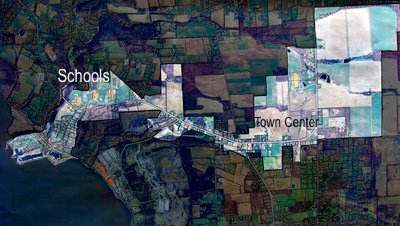- By Dan Veaner
- News
 Print
Print  After a valiant attempt to create a viable sewer project despite state rules and financial challenges, the Town of Lansing sewer project was killed in July of 2007. Unless the DEC relaxed their stance requiring municipal shared sewage treatment it would be impossible to bring sewer to the town at an affordable price. But Town officials and community leaders continued to view a sewer as key to the success of a new town center and to attracting new business to Lansing to help offset revenue losses from the struggling AES Cayuga power plant PILOT.
After a valiant attempt to create a viable sewer project despite state rules and financial challenges, the Town of Lansing sewer project was killed in July of 2007. Unless the DEC relaxed their stance requiring municipal shared sewage treatment it would be impossible to bring sewer to the town at an affordable price. But Town officials and community leaders continued to view a sewer as key to the success of a new town center and to attracting new business to Lansing to help offset revenue losses from the struggling AES Cayuga power plant PILOT.A lot has changed since 2007. The key change is that the New York State Department of Environmental Conservation (DEC) is no longer insisting that Lansing send its sewage via a pipeline through the Village of Lansing to the Cayuga Heights Treatment Plant. That makes it possible for the Town to build its own plant, reducing costs to residents and businesses within the proposed sewer district significantly.
The failed 2007 project would have cost district residents $854 per Equivalent Dwelling Unit (EDU -- it more or less means the equivalent of a house) annually over a 30 year period. Sewer committee members and town officials conceded at that time that it was too expensive and would have been voted down by prospective sewer district residents if it had been brought to a vote. The new plan could cost about $595 the first year, slowly rising over a 30 year period.
But that is a worst case scenario. The more EDUs that join a sewer district, the lower the cost per EDU, because it is an expense shared among all residents of the district. With two major housing developments and a business park already being contemplated for the new town center, sewer committee members estimate that the initial cost per EDU could be as low as $500 in the first year.
Town officials began exploring the possibility of an affordable sewer soon after the 2007 project was withdrawn. A map plan was completed in 2011 using a lot of the work that had been completed for the 2007 project, thus saving a great deal of money. As the Sewer Committee nails down details of the new proposal, key elements like the exact number and location of EDUs within the proposed sewer district and the cost per EDU continue to shift. At the beginning of Tuesday's meeting the committee was basing its estimates on 735 EDUs.
 The light area on this map shows that parts of Lansing to be included in the new sewer district. The committee continues to adjust the boundaries to best serve the community and keep costs down.
The light area on this map shows that parts of Lansing to be included in the new sewer district. The committee continues to adjust the boundaries to best serve the community and keep costs down.While parts of the sewer district boundaries are still in flux, the general area to be covered is defined. From the west the district starts at Myers Park and includes the Ladoga Park neighborhood that often suffers from flooding that threatens to dump effluent from septic systems into Cayuga Lake. It goes north to include the Lansing Schools, for whom a sewer would solve septic system challenges the school district has struggled with for years. The district continues east along Ridge Road, including the new town center, then moving north to the youth incarceration centers and Kingdom Farm.
"The Town leaders and staff desire to have commercial development within the service area," says an introduction to the map plan. "The lack of a centralized sanitary sewer is a determent to commercial development."
This week's meeting covered kinds of sewage treatment plants as well as EDUs and costs. A likely site for a treatment plant has been tentatively identified, and the committee contemplated possible changes to the makeup of the sewer district that will determine which properties will initially be served.
The committee is being chaired by former Town Supervisor Scott Pinney, who is joined by members of the old sewer committee as well as new members. Noel Desch, Andy Sciarabba, Ed LaVigne, Supervisor Kathy Miller, Michael Koplinka-Loehr, Dale Baker, Tom Jones, and Town Engineering and Planning Coordinator Jeff Overstrom make up the current committee.
This group has already visited a sewage treatment plant in Minoa, NY, a plant that is used in sewer treatment research as well as actually serving the village's treatment needs. That plant uses Sequencing Batch Reactors (SBR), as well as wetlands treatment, and researchers that told committee members about those and lagoon treatment systems. Pinney says he would like to come up with an affordable green system for Lansing.
To help decide on the kind of treatment plant needed the committee decided to try to arrange a tour of Groton's sewer plant, which is approximately the capacity that Lansing would need. In the near future the committee hopes to nail down the exact boundary of the proposed district, the location and type of the treatment plant, costs, and financing.
That is critical," Sciarabba said. "We're far enough down the road with the engineering and the number of EDUs. If we haven't got the financing where do we go?"
That means there is a lot of work to do before beginning a series of public information meetings that the committee hopes to begin later this year. But enough work has already been done that the Town of Lansing could potentially have a sewer within the next couple of years.
The new system is projected to cost significantly less than the 2007 proposal, and it doesn't have the political baggage that system had because of fierce resistance from the Village of Lansing, which did not want a trunk line going from the Town of Lansing to the Cayuga Heights plant. New building in the town center will reduce costs for individuals, if not in the first year or two, certainly in the remainder of the 30 year municipal loan period. Federal and state grants for infrastructure may also help reduce costs.
"I recommend that we pick a green system just in case grant money for that comes along in the next year," Pinney said.
When it comes down to a vote cost will be the key factor. Home and business owners with aging septic systems will have to feel that a sewer will be a better financial solution than replacing individual septic systems. The hope is that the sewer will not only be attractive financially to current residents, but will attract new ones to mitigate the tax burden current residents are bearing. At this stage the committee is tweaking the plan to make that a reality.
v8i4


